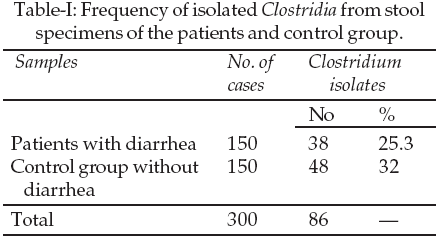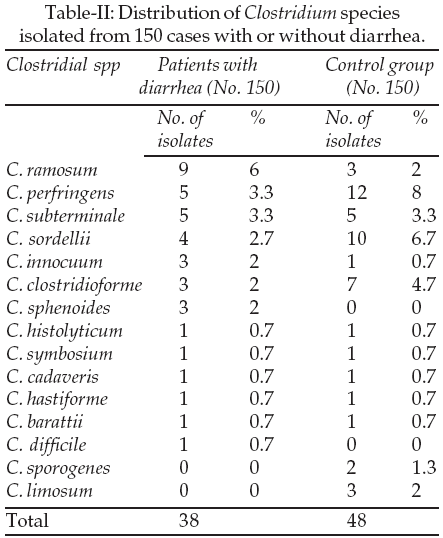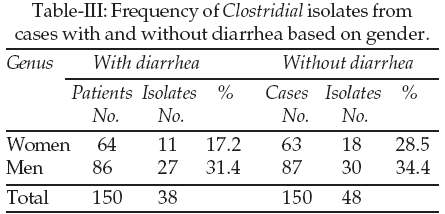|
|
||||
|
Published by : PROFESSIONAL MEDICAL PUBLICATIONS |
||||
|
ISSN 1681-715X |
||||
|
||||
|
- |
||||
|
ORIGINAL ARTICLE- |
||||
|
- |
||||
|
Volume 24 |
April - June 2008 (Part-I) |
Number 2 |
||
|
|
||||
|
|
||||
|
|
||||
|
Published by : PROFESSIONAL MEDICAL PUBLICATIONS |
||||
|
ISSN 1681-715X |
||||
|
||||
|
- |
||||
|
ORIGINAL ARTICLE- |
||||
|
- |
||||
|
Volume 24 |
April - June 2008 (Part-I) |
Number 2 |
||
|
|
||||
|
|
||||
A survey of clostridia in the patients with acute
diarrhea compared with the control group
Mojtaba Moosavian1, Koorosh Hayati2
ABSTRACT
Objective: Clostridia are widely distributed in natural environments and are inhabitants of both human and animal gastrointestinal tract. These organisms are important pathogens that may cause pseudomembranous colitis, necrotizing enteritis, food poisoning and the other intestinal disorders, such as diarrhea. The objective of this study was to determine the prevalence of Clostridium species in the hospitalized patients and to compare them with healthy subjects as a control group.
Methodology: A total of 300 stool specimens were collected from 150 patients with acute diarrhea (In three hospitals affiliated with to Jondishapour University of Medical Sciences in Ahwaz City in Iran) and 150 cases without diarrhea as a control group. After ethanolic treatment, the specimens were inocolated onto culture media such as: Blood Agar and Selective CCFA Medium (Cycloserine–Cefoxitin–Fructose Agar). The plates were incubated under anaerobic coditions and the grown colonies were presumptively identified as Clostridia, based on their morphology, Gram‘s stain, aerotolerant test and situation of bacterial spores. The species of these Clostridia were definitively determined by the other standard tests such as: Motility, SH2, Indol and biochemical tests.
Results: This study resulted in isolation of Clostridia spp from 38 patients (25.3%) and 48 cases (32%) of control group. Fifteen different species of Clostridia were isolated from the patients and control group. The most predominat isolated species were ramosum, perfringens, subterminale, sordellii, innocuum, clostridioform and sphenoides.
Conclusions: Based on the results obtained, there was no significant difference between the Clostridia spp isolated from the patients and control group, so more studies are recommended for clarifying the role of Clostridia spp in causing diarrhoea.
KEY WORDS: Clostridia, Anaerobic bacteria, Antibiotic dependent diarrhea.
Pak J Med Sci April - June 2008 (Part-I) Vol. 24 No. 2 209-212
1. Mojtaba Moosavian, Ph.D
Infectious & Tropical Diseases Research Center,
2. Koorosh Hayati, Msc
Razi Hospital,
1-2: Ahwaz Jundishapour University of Medical Sciences,
Ahwaz – Iran.
Correspondence
Mojtaba Moosavian, Ph.D
Dept. of Microbiology, School of Medicine,
Ahwaz Jundishapour University of Medical Sciences,
Ahwaz – Iran.
E-mail: moosavian_m@yahoo.com
* Received for Publication: April 4, 2007
* Revision Received: January 9, 2008
* Revision Accepted: January 15, 2008
INTRODUCTION
Clostridium spp. are widely distributed in the environment. Some of these Clostridia are inhabitants of human gastrointestinal tract and may cause intestinal disorders such as diarrhea, pseudomembranous colitis, necrotizing enteritis and food poisoning.
1-3 However, most cases of clostridial infectious are seen in patients with a history of trauma, recent surgery, diabetes, colon cancer, skin infections/burns and septic abortions.4-7 Based on role of pathogenesis, Clostridia are classified in 5 groups: Group I, related to myonecrosis or gas gangrene including: C. perfringens, C. septicum, C. novyi, C. bifermentans, C. histolyticum and C. sordellii. Group II which causes tetanus, including C. tetani, Group III, cause botulism, including C. botulinum, Group IV which causes acute diarrhea associated with antibiotic-associated and pseudomembranous colitis, including C. difficile, and Group V related to cerebral abscesses, abdominal and gynecologic infections, pneumonia and bacteremia, including: C. perfringens, C. ramosum, C. bifermentans.5,8,9 This study was designed for isolation and identification of Clostridium spp from diarrhea specimens of hospitalized patients and stool specimens of healthy cases with out diarrhea (as a control group) and to compare the results obtained from two groups which were examined.METHODOLOGY
Sampling: A total of 300 stool specimens were collected and examined from 150 patients who suffered from acute diarrhea and 150 healthy cases without diarrhoeal disease, as a control group, which were referred to the other hospital units. The patients were hospitalized in three hospitals (Razi, Abuzar and Golestan) affiliated with Jondishapour University of Medical Sciences, Ahwaz, Iran. They had no problem except acute diarrhoea and each sample was taken from the patient before any antibiotic therapy.
Eighty six out of 150 patients and 87 out of 150 healthy cases were women while rest of them (64 patients and 63 healthy cases) were men. Inclusion criteria for the patients was affliction by acute diarrhoea which was determined as three loose stool per day, at least for two days, based on definition.
1 The patients who used antibiotics before sampling, immuno compromised cases such as who suffered from any malignant conditions, or were under corticosteroid therapy and pregnant women were excluded from this study. A questionnaire form was simultaneously completed for each patient and control case during sampling. Stool specimens were treated by 95% ethanol for 35-45 minutes,10-12 then a portion of each sample was inoculated onto a blood agar (Merk) and a selective–cycloserine-cefoxitin-fructose agar plate(CCFA). The plates were incubated in anaerobic conditions, at 37ºC for 48 hours. Incubation of plates were continued for additional 72 hours, if they were negative for growth, in primary verifying.1,10Grown colonies on blood agar and CCFA media, were examined by gram stain and aerotolerance test, then they were identified as Clostridium spp. by biochemical standard tests such as : production of SH2, Indol and motility in SIM medium, and the fermentation of maltose, lactose, glucose, fructose, sucrose and manitol. Difinitive identification of species was performed by referring to standard tables.
13,14 The results for both groups of the patient and control were analysed by Chi-Square test.RESULTS
In this study, a total of 300 stool specimens from two groups of case and control were studied. Their status and frequency of isolated Clostridia are shown in Table-I. The species of isolated Clostridia were differentiated from each others, by biochemical tests.

Table-II shows the prevalence of 13 different species of Clostridia which were isolated from 150 patients compared with 150 control (Normal) cases. C. ramosum and C. perfringens were the most frequently isolates from the patients and control group, respectively. C. difficile was isolated only from 0.7% stool specimen of the patients with diarrhea, but this species of bacterium was not known in healthy cases specimens.

The results of this study based on genders showed significant difference (P<0.05) between isolated Clostridia from men and women (Table-III). Although, the age distribution of patients and normal cases was between 1-80 years, but most of them (with or without diarrhea) belonged to age group 1-10. So, most of the Clostridium spp, were also isolated from this age group (1-10), including 34 out of 38 isolates from the patients and 20 out of 48 isolates from control group.

DISCUSSION
Clostridium spp. are found ubiquitous in nature. They are a part of intestinal commensal anaerobic micro flora of human, other vertebrates, insects or existing in form of spores that can be viable definitely.
5,15 They may be cause of both endogenous and exogenous infections. Since these organisms act synergistically with other pathogens, determination of their role in pathogenesis difficult to establish.15 Even otherwise, many clinical laboratories don’t routinely examin patient’s specimens for recovery of anaerobic organisms. So, in this study, we have tried to show frequency of Clostridia in the 150 patients with acute diarrhoea in comparison with the results obtained from 150 cases without diarrhoea, as a control group.Isolation of 38 Clostridium spp. (25.3%) from the patients with acute diarrhea did not show significant difference compared with control group with 48(32%) isolates (P >0.05). It has been suggested that some factors such as immunological alterations, age, nutritional conditions, genetic factors, pathologies or antimicrobial therapy can interfere on the Clostridia isolation.
16 In this study, however, less number isolates of Clostridium spp. from the patients may be related to increased intestinal motility because of diarrhoea. In a similar study, Ferreira C.E. et al. showed prevalence of Clostridium spp. 20% (18 cases) in patients with diarrhoea and 21% (19 cases) in children without diarrhoea. They examined stool specimens from children with (90 samples) and without diarrhoea (91 samples), respectively.1In our study the most frequent isolates from 150 patients or 150 control cases, consisted of C. ramosum with 9(6%) and C. perfringens with 12(8%) species, respectively. Whereas some of the species, such as C. histolyticum, C. symbosium, C. cadaveris, C. hastiforme and C. barattii had the lowest isolates (0.7%) in both the patient and control groups. Although, some of these species were isolated in a few numbers, however, their role in pathogenesis can be important. Clostridial exo-spore which can remain viable in environment, may be introduced into an oxygen-reduced environment and then to germinate. Some of these certain pathogenic species may liberate powerful exotoxins that can have sever and life-threating effects, particularly among injecting drug users.
5,17,18In spite of using CCFA as a selective medium,
19 recovered C. difficile was 0.7% from patients. C. difficile is an important nosocomial pathogen and is associated with outbreaks of pseudo membranous colitis and diarrhea in children or adults in mild to severe and fulminant form and eventually resulting in death.1,20 Prevalence of C. difficile has been reported differently based on geographic and hygienic conditions in different countries.1,21 In addition to, isolation methods of C. difficile can not show presence of less than 100 bacteria in one gram of stool specimen in a normal person.22 So, absence of C. difficile in normal stool specimens under study is not a strong reason for non-existence of this bacteria in bowel.Although Table-III shows that the number of Clostridium isolates from stool specimens of control group (48 isolates) are more than the patients (38 isolates), no significant difference (P>0.05) were observed between them. However, the number of Clostridium isolates in men, in both groups with (31.4%) and without (34.4%) diarrhoea were more than in women and so, the difference was significant (P<0.05).
CONCLUSIONS
In view of the fact that Clostridia normally reside in gastrointestinal tract, results obtained in our study showed no significant difference between the Clostridium spp. isolated from the patients and control group, the results which has also been showed in some other studies.
1 However, more studies are recommended for clarifying the role of Clostridium spp. in the causation of diarrhoea.REFERENCES
1. Ferreira CE, Nakano V, Durigon EL, Avila-Campos MJ. Prevalence of Clostridium spp. and Clostridium difficile in children with acute diarrhoea in Saopoulo city, Brazil. Mem Inst Oswaldo Cruz, Rio de Janeiro 2003;98(4):451-4.
2. Freeman J, Wilcox MH, Antibiotics and Clostridium difficile. Microb Infect, 1999;1:377-84.
3. Lorber B. Gas Gangrene and other Clostridium-associated diseases, In: Mandell GL., Bennett JE. And Dolin R. (eds), Principles and practice of infectious disease. 6th ed. Vol. 2, Elsevier Churchill Livingston, USA, 2005; 2828.9 (Please check page number)
4. Smith-Slatas CL, Bourque M, Salazar JC. Clostridium septicum infections in children: A case report and review of the literature. Pediatr 2006;117(4):e796-e805.
5. Brazier JS, Duerden BI, Hall V, Salmon JE, Hood J, Brett MM. Isolation and identification of Clostridium spp. from infections associated with the injection of drugs: experiences of a microbiological investigation team. J Med Microbiol 2002;51:985-9.
6. Turnbull TL, Cline KS. Spontaneous Clostridial myonecrosis. J Emerg Med 1985;3:353-60.
7. Cline KA, Turnbull TL. Clostridial myonecrosis. Ann Emerg Med 1985;14:459-66.
8. Delost MD. Introduction to Diagnostic Microbiology, Mosby, USA, 1997;280.
9. Winikoff B. Clostridium sordellii infection in medical abortion. Clin Infect Dis 2006;43:1447-8.
10. Marler LM, Siders JA, Wolters LC, Pettigrew Y, Skitt BL, Allen SD. Comparison of five cultural procedures for isolation of Clostridium difficile from stools. J Clin Microbiol 1992;30(2):514-6.
11. Clabots CR, Gerding SJ, Olson MM, Peterson LR, Gerding DN. Detection of asymptomatic Clostridium difficile carriage by an alcohol shock procedure. J Clin Microbiol 1989;27:2386-7.
12. Koransky JR, Allen SD, Dowell Jr. VR. Use of ethanol for selective isolation of Spore forming microorganisms. Appl Environ Microbiol 1978;35:762-5.
13. Engelkirk PG, Duben-Engelkirk J. Anaerobes of Clinical Importance In: Mahon CR, Manuselis G, Textbook of Diagnostic Microbiology. WB Saunders Company, USA, 1995;147-150, 570.
14. Collee JG, Brown R, Poxton IR, Fraser AG. Clostridia of wound infection In: Collee JG, Duguid JP, Fraser AG, Marmion BP. Practical Medical Microbiology, 3 th ed. Churchill Livingstone, New York, 1990;571-99.
15. Van der Vorm ER, Von Rosenstiel IA, Spanjaard L, Dankert J. Gas gangrene in an immunocompromised girl due to a Clostridium ramosum infection. Clin Infect Dis 1999;28:923-4.
16. Zhang G, Svenungsson B, Karnell A, Weintraub A. Prevalence of enterotoxigenic Bacteroides fragilis in adult with diarrhea and healthy controls. Clin Infect Dis 1999;29:590-4.
17. Aldape MJ, Bryant AE, Stevens DL. Clostridium sordellii infection: Epidemiology, clinical findings and current perspectives on diagnosis and treatment. Clin Infect Dis 2006;43:1436-46.
18. Jankowska-Steifer E, Jozwiak J, Grzela T, Komar A, Niderla J, Lazarczyk M, et al. Vacuolization of Hela cells by a partially purified Clostridium hystolyticum cytotoxin. FEMS Immunol Med Microbiol 2006;46:360-6.
19. George WL, Sutter VL, Citron D, Finegold SM. Selective and differential medium for isolation of C. difficile. J Clin Microbiol 1979;9:214-9.
20. CDC, Severe Clostridium difficile – associated disease in populations previously at low risk- four states. MMWR, 2005;54(47):1201-5.
21. Pepin J, Valiquette L, Alary M-E, Villemure Ph, Pelletier A, Forget K. Clostridium difficile – associated diarrhea in a region of Quebec from 1991 to 2003: a changing pattern of disease severity. CMAJ 2004;171(5):466-72.
22. Malekzadeh F. Microbiology. 2 th ed., Tehran University Press, Tehran, Iran 1995;448-56.
HOME | SEARCH | CURRENT ISSUE | PAST ISSUES
Professional
Medical Publications
Room No. 522, 5th Floor, Panorama Centre
Building No. 2, P.O. Box 8766, Saddar, Karachi - Pakistan.
Phones : 5688791, 5689285 Fax : 5689860
pjms@pjms.com.pk